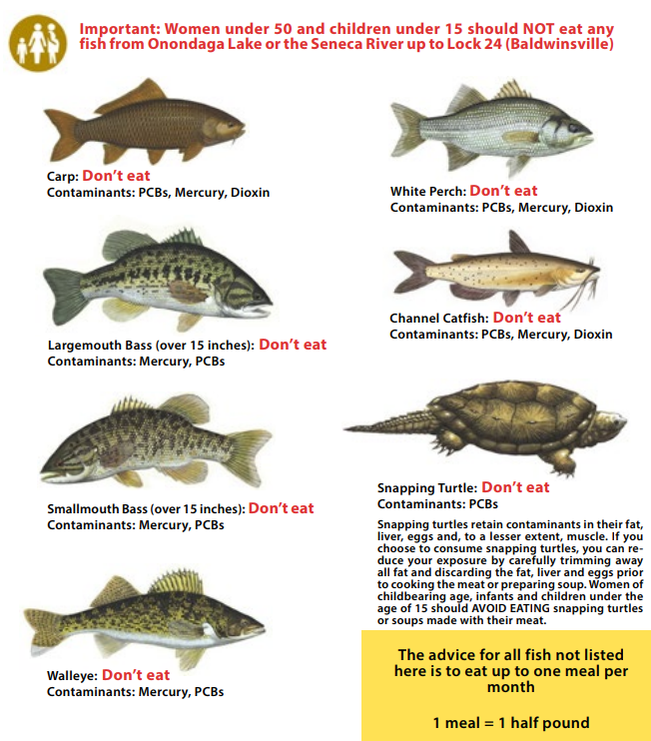Consuming Fish from Onondaga Lake: An Important Environmental Health and Justice Issue
8/20/2018
By Paul Harris and Alma Lowry

The on-going recovery of Onondaga Lake is the story of a natural resource rebounding from the brink of oblivion and a cornerstone of Atlantic States Legal Foundation’s (ASLF) legacy. Today, over 60 species of fish can be found in the Lake and recreational anglers are rediscovering the world-class fishing opportunities provided. However, this good news brings challenges of its own. While recreational anglers may enjoy catch-and-release fishing, a recent study by the New York State Department of Health (DoH) found that many Syracuse residents were catching and eating the fish at unsafe levels and, even more concerning, were unaware of the health risks posed by this practice.
Despite improvements in water quality, mercury and PCB persist at unsafe levels in Onondaga Lake fish and sediments. Eating fish from Onondaga Lake increases the risk of cancer, birth defects, and impaired childhood development. In response, DoH issued a strict fish consumption advisory for Onondaga Lake, which suggests no more than one lake-caught fish meal per month for most people and most fish species. Children and women of child-bearing age are advised to eat no Onondaga Lake fish. Given the hazard posed, DoH’s finding that the majority of anglers surveyed within the Bhutanese, Burmese and non-immigrant Southside community were unaware of the fish advisory – and that many refugees had elevated levels of blood mercury – is deeply alarming. More needs to be done, and quickly.
This environmental justice issue stems in part from inadequate risk communication. In our experience, Burmese and Bhutanese refugees, other refugee groups, Spanish-speaking immigrants and migrants, and lower-income inner-city residents are most likely to be fishing for food and least likely to be aware of the advisory. The DoH fish consumption advisory is not designed to address cultural and social differences, English language ability, literacy, and other factors related to information access. The results of DoH’s study demonstrate this gap.
Addressing this urgent public health issue has been on the ASLF agenda for more than a decade. Working with the Onondaga Lake Watershed Partnership (OLWP), we have been developing a strategy to reach at-risk angler groups, as well as those who consume fish from Onondaga Lake. One recent success has been the installation of warning signs at various fishing access points around the lake. These signs are in four different languages (English, Spanish, Burmese, Nepali), and present the advisory in graphical form for the benefit of those with low or no literacy.
While this achievement is gratifying, more networking, education, and direct communication is needed to increase awareness. Working with OLWP, we are developing a plan to do this work. We are developing tools to identify the communities most at risk of exposure through fish consumption and are building partnerships with the community groups, and refugee service organizations that will be crucial in securing the buy-in of these groups.
ASLF is committed to protecting communities from the dangers of contaminated fish consumption. However, funding and volunteer support are desperately needed for this labor-intensive work. If you would like to find out more about how you can help – whether through a donation or volunteering time – please contact us.
To access ASLF fish advisory pamphlets (English, Spanish, Burmese) and other related information please visit our Health Advisories & Outreach page.
Consuming Fish from Onondaga Lake: An Important Environmental Health and Justice Issue Read More »
